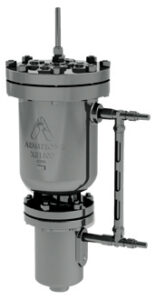 To do its job well, a refrigeration system must deliver refrigerant to heat exchanger surfaces free of air and other non-condensable gasses. When air is present, it forms an insulating film on the inside surface of the coils. This, in effect, reduces the size of the condenser. To offset this situation, the temperature and pressure of the refrigerant gas must be increased—and that is expensive. Why? Higher pressure leads to increased compressor power costs and the need for more cooling water, which is also expensive. Excess head pressure puts more strain on bearings and drive motors, belts and gasket seals, leading to premature failure of these components. In addition, higher pressure leads to increased temperature, shortening the life of compressor valves and breaking down lubricating oil. The solution, of course, is to purge the system of unwanted air and other non-condensable gases. Armstrong’s developments and improvements in refrigerated purger design and function have led to significant savings in energy, time and money.
To do its job well, a refrigeration system must deliver refrigerant to heat exchanger surfaces free of air and other non-condensable gasses. When air is present, it forms an insulating film on the inside surface of the coils. This, in effect, reduces the size of the condenser. To offset this situation, the temperature and pressure of the refrigerant gas must be increased—and that is expensive. Why? Higher pressure leads to increased compressor power costs and the need for more cooling water, which is also expensive. Excess head pressure puts more strain on bearings and drive motors, belts and gasket seals, leading to premature failure of these components. In addition, higher pressure leads to increased temperature, shortening the life of compressor valves and breaking down lubricating oil. The solution, of course, is to purge the system of unwanted air and other non-condensable gases. Armstrong’s developments and improvements in refrigerated purger design and function have led to significant savings in energy, time and money.
 Kenya |
Kenya |  Rawanda |
Rawanda |  Tanzania |
Tanzania |  Uganda
Uganda
